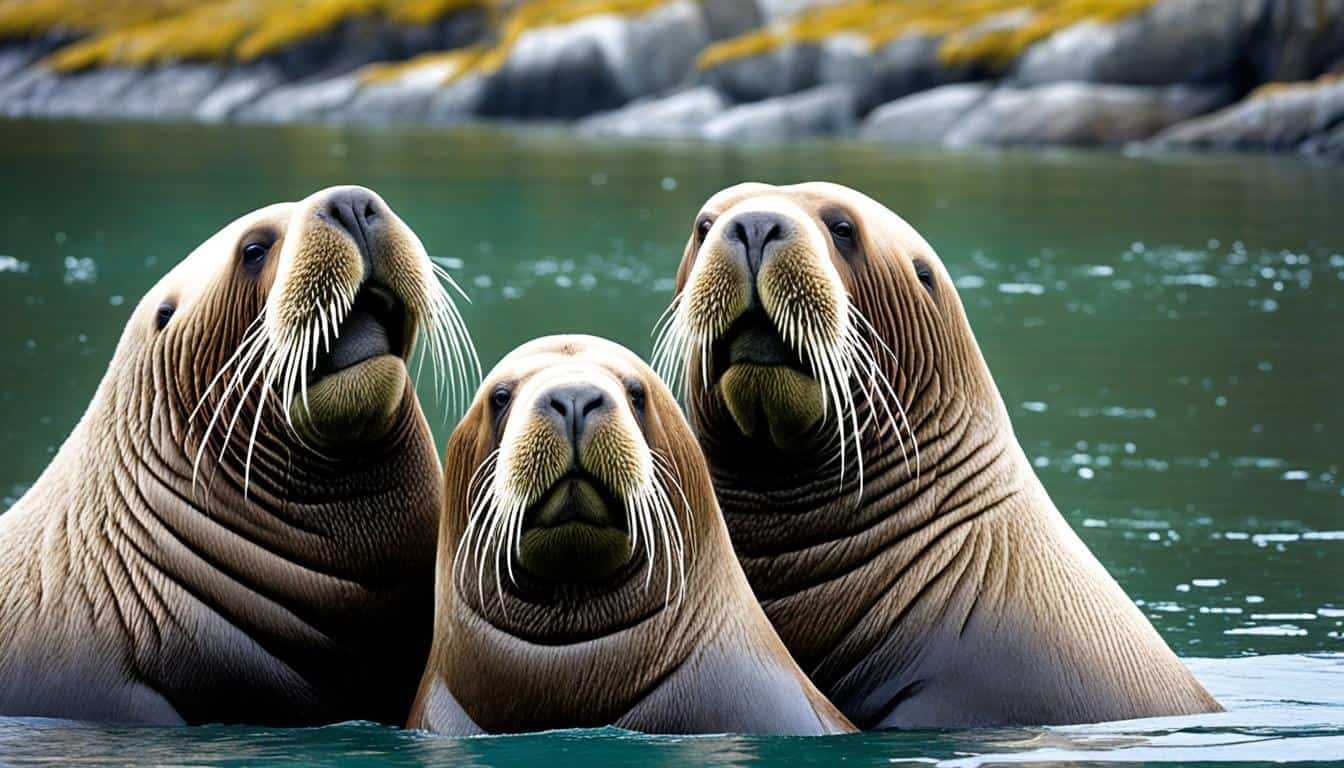When you think of the Arctic’s wildlife, the walrus is a standout. These marine mammals, known as Odobenus rosmarus, are part of the pinniped family. They’re known for their long tusks, unique whiskers, and big size.
Understanding walruses means knowing their special traits and their role in the ecosystem. They live in the cold Arctic, needing sea ice for rest and breeding. This is crucial for their survival.
Learning about walruses also highlights the challenges they face from climate change and environmental threats. It’s important to understand these issues to help protect them.
Introducing the Walrus: Characteristics and Appearance
Walruses are amazing marine mammals with unique looks and big size. They have special features that help them live in the Arctic. Let’s dive into their world to learn more about their skills and social life.
Physical Features of Walruses
The walrus appearance stands out with its thick, wrinkled skin. This skin can be brown or pink and keeps them warm in the cold. They have long whiskers that help them feel their way in the dark waters. Their flat flippers let them move easily underwater.
Both male and female walruses have long tusks, up to three feet long. These tusks are vital for pulling themselves out of the water and breaking ice to breathe.
Size and Weight
Walruses can be really big. Male Pacific walruses can be as long as 3.6 meters (11.75 feet) and weigh over 1,500 kg (1.5 tons). Females are smaller but still quite large. On average, walruses are between 7.25 and 11.5 feet long.
They can live up to about 40 years in the wild. This makes them interesting to study and observe.
| Walrus Characteristics | Physical Features | Size and Weight |
|---|---|---|
| Skin Color | Wrinkled brown and pink skin | Length: 7.25 – 11.5 feet |
| Tusks | Long elongated canine teeth, up to 3 feet | Male Weight: Over 1,500 kg |
| Flippers | Flat flippers for swimming | Female Weight: Smaller than males |
| Average Lifespan | Adaptations for cold environments | Up to 40 years |
What are walruses? Understanding Their Species and Habitat
Walruses are amazing marine mammals that come in two main types: the Atlantic and the Pacific walrus. Each type lives in its own special place, showing how they adapt to their homes. The Atlantic walrus lives in the northern waters of Canada, Greenland, Norway, and Russia. The Pacific walrus calls areas from Alaska to Russia home.
Two Main Subspecies
Knowing the difference between the Atlantic and Pacific walruses helps us understand their numbers. The Atlantic walrus has about 25,000 individuals, much fewer than the 200,000 Pacific walruses. These numbers change due to things like hunting and where they can live.
Walrus Habitat
Walruses love certain places, often choosing shallow waters with lots of sea ice. This special place is key for resting, breeding, and staying safe from predators. The Pacific walrus goes to the Chukchi Sea’s continental shelf in spring and summer for food. Both types need sea ice to survive.

| Walrus Species | Population Estimate | Habitat Locations |
|---|---|---|
| Atlantic Walrus | ~25,000 | Canada, Greenland, Norway, Russia |
| Pacific Walrus | ~200,000 | Alaska, Russia |
Walrus Diet: What Do They Eat?
Walruses eat a diet rich in benthic invertebrates. They hunt these in their natural habitat. Their eating habits show how adaptable they are and their important role in marine ecosystems.
Feeding Habits
Walruses are meat-eaters, eating many types of benthic invertebrates. They eat clams, mollusks, snails, and sea cucumbers. They find food in shallow waters, using their sensitive whiskers to find prey under the ocean floor.
Feeding Techniques
Walruses have special ways to find food that help them succeed. They dive up to 100 feet deep to find food. Their whiskers help them detect prey, and their tusks help break up the seabed to find shellfish.
| Food Source | Common Techniques | Key Features |
|---|---|---|
| Clams | Dive to find | Soft-bodied, abundant |
| Mollusks | Whisker detection | Tasty, nutrient-rich |
| Snails | Digging with tusks | Hard shells, varied sizes |
| Sea Cucumbers | Surface and shallow foraging | Algal feeders, soft-bodied |
Walrus Behavior and Social Structure
Walruses show interesting behaviors and social dynamics. They live in groups, which helps us understand their social life. These animals have strong bonds and clear social ranks.
Social Habits
Walruses love to be around others, forming big groups of hundreds. They rest on ice floes together. Social ties are key; they help with caring for young and staying safe.
They also have a social order in their groups. This helps them work together when finding food or resting.
Adaptations and Communication
Walruses have special traits to survive in cold water. They can slow down their heart to stay underwater longer, helping them find food. They talk to each other using sounds, body language, and touch.
This way of communicating is vital for staying close and getting along in their group.
Walrus Conservation: Challenges and Efforts
Walrus conservation is now more urgent than ever. These marine mammals face many challenges. Climate change is a big threat, causing sea ice to melt. This ice is crucial for their survival.
Without it, walruses find it hard to rest and find food. This affects their health and numbers.
There are efforts to help walruses, like limiting hunting and creating safe areas. But, illegal hunting and human activities like shipping and tourism are still threats. These activities harm walruses and make their lives harder.
The World Wildlife Fund (WWF) is leading the fight against climate change’s impact on walruses. They call for global action and strong conservation plans. By supporting these efforts, you help protect these amazing creatures for the future.
FAQ
What are walruses?
Walruses are big marine mammals in the pinniped family, known as Odobenus rosmarus. They stand out with their long tusks, whiskers, and big size. They live in the cold Arctic, needing sea ice for rest and breeding.
How much do walruses weigh?
Male Pacific walruses can weigh over 1,500 kg (1.5 tons). Females are smaller. On average, they grow up to 11.5 feet long and live about 40 years in the wild.
Where do walruses live?
Walruses live in shallow waters, often near seasonal sea ice. Atlantic walruses are found in northern Canada, Greenland, Norway, and Russia. Pacific walruses live from Alaska to Russia.
What do walruses eat?
Walruses mainly eat benthic invertebrates like clams, mollusks, snails, and sea cucumbers. They use their sensitive whiskers to find prey on the ocean floor.
How do walruses communicate?
Walruses communicate with sounds, body language, and touch. These methods help show social rank and keep groups together.
What threats do walruses face?
Climate change is a big threat, as it reduces their sea ice habitat. Illegal hunting and human activities like shipping and tourism also pose risks.
How are walruses adapted to their habitats?
Walruses have a thick blubber layer to stay warm in cold waters. They can slow their heart rates for deep dives, helping them survive in their cold home.







